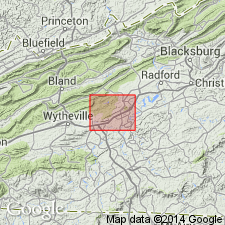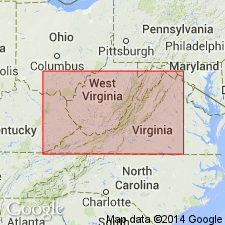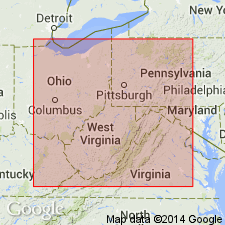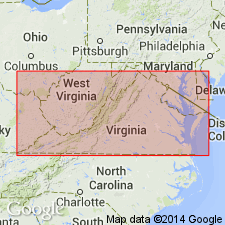
- Usage in publication:
-
- Millboro shale
- Modifications:
-
- Named
- Dominant lithology:
-
- Shale
- AAPG geologic province:
-
- Appalachian basin
Summary:
Named the Millboro shale. Name is attributed to Charles Butts. The name Millboro replaces Devonian Black shale used previously. Unit is 750 feet thick and comprises two members, a lower Marcellus member and an upper Naples member. The Millboro shale overlies the Onondaga formation and underlies the Brallier formation.
Source: GNU records (USGS DDS-6; Reston GNULEX).

- Usage in publication:
-
- Millboro shale
- Modifications:
-
- Areal extent
- AAPG geologic province:
-
- Appalachian basin
Summary:
Millboro shale is applied to the area southwest of Shenandoah Co., VA, where the Hamilton is absent. Shale of the Millboro is constant in its occurrence between the Onondaga and Brallier from Highland and Augusta Cos. southwest to TN. Thickness of the Millboro shale is 200 to 1000 feet. Type locality is designated at Millboro Springs, Bath Co., VA.
Source: GNU records (USGS DDS-6; Reston GNULEX).

- Usage in publication:
-
- Millboro shale member
- Modifications:
-
- Revised
- AAPG geologic province:
-
- Appalachian basin
Summary:
Reduced the rank of the Millboro to the Millboro shale member of the Romney shale. In the Clifton Forge district, the Millboro shale member conformably overlies and grades into the Needmore shale member. Unit is of Middle and Late Devonian age.
Source: GNU records (USGS DDS-6; Reston GNULEX).

- Usage in publication:
-
- Millboro shale
- Modifications:
-
- Areal extent
- AAPG geologic province:
-
- Appalachian basin
Summary:
Geographically extended the Millboro shale into WV, PA, and MD. The unit is equivalent to the Marcellus shale, Hamilton formation, and Tully limestone. The Millboro overlies the Tioga metabentonite and underlies the Harrell shale or Brallier shale. The age of the Millboro shale is Middle Devonian.
Source: GNU records (USGS DDS-6; Reston GNULEX).

- Usage in publication:
-
- Millboro Member
- Modifications:
-
- Revised
- AAPG geologic province:
-
- Appalachian basin
Summary:
Geographically extended the Millboro to TN and revised it as the Millboro Member of the Chattanooga Shale. Unit unconformably overlies the Silurian Sneedville Limestone or the Lower Devonian Wildcat Valley Sandstone, and underlies the Brallier Member of the Chattanooga Shale. The Millboro Member is of Late Devonian age.
Source: GNU records (USGS DDS-6; Reston GNULEX).

- Usage in publication:
-
- Millboro Shale
- Modifications:
-
- Areal extent
- AAPG geologic province:
-
- Appalachian basin
Summary:
Within the Millboro Shale in the study area are 64 ft of limestones and calcitic shales that compose the Purcell Member. Though previously described in this area, the strata until now have not been given a name. The Purcell here also contains barite nodules. The shale and limestone can be traced from near Salem northward into central PA and from there, in the subsurface, to the type Cherry Valley Limestone outcrop within the Marcellus Shale of NY. The Tioga Ash Beds occurs just above the Millboro-Needmore contact. The Millboro is 1250 ft thick in the Catawba syncline. Underlies the Brallier Formation or possibly the Tully Limestone. Unit may be entirely Middle Devonian in the study area.
Source: GNU records (USGS DDS-6; Reston GNULEX).
For more information, please contact Nancy Stamm, Geologic Names Committee Secretary.
Asterisk (*) indicates published by U.S. Geological Survey authors.
"No current usage" (†) implies that a name has been abandoned or has fallen into disuse. Former usage and, if known, replacement name given in parentheses ( ).
Slash (/) indicates name conflicts with nomenclatural guidelines (CSN, 1933; ACSN, 1961, 1970; NACSN, 1983, 2005, 2021). May be explained within brackets ([ ]).

